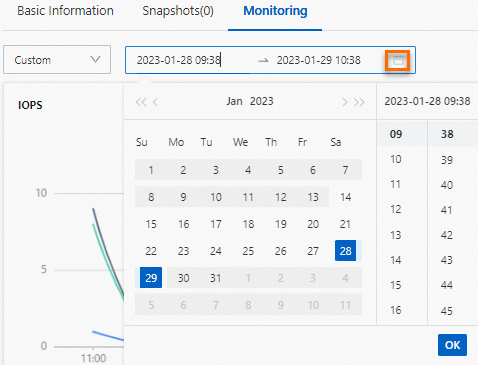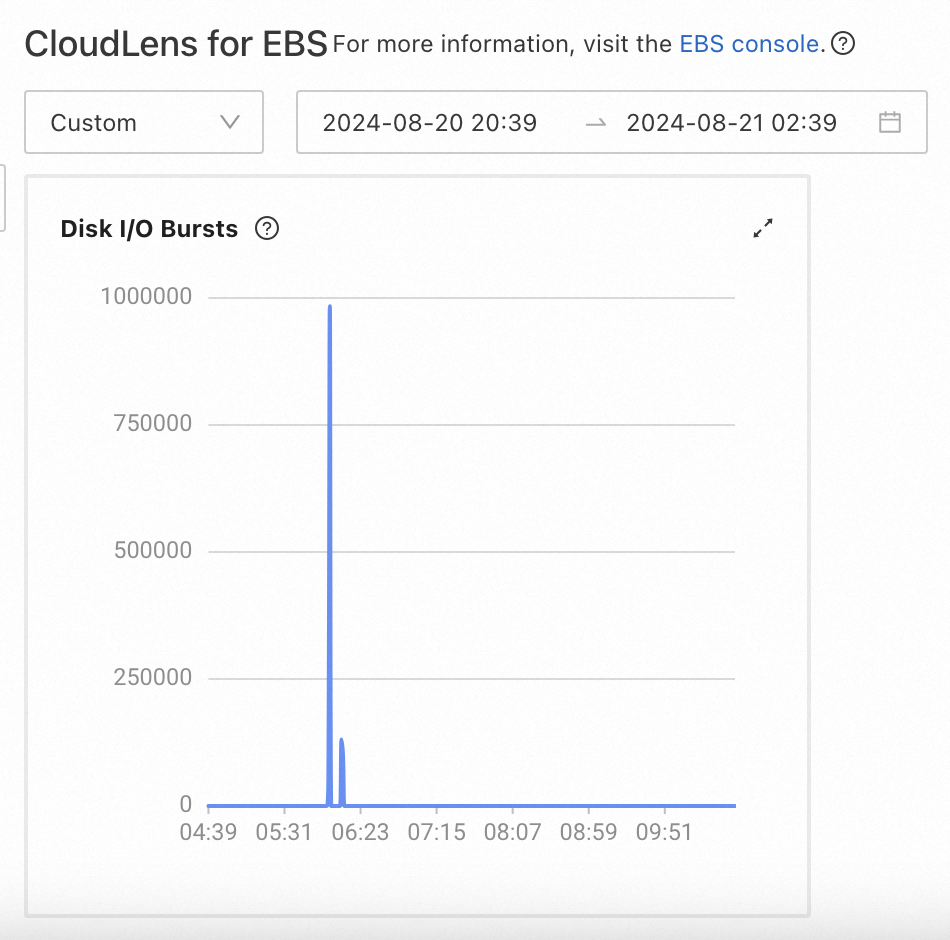This topic describes how to view the monitoring data of cloud disks attached to Elastic Compute Service (ECS) instances to effectively monitor system performance and stability.
Background information
Disk performance is measured by using the following metrics:
IOPS: measures the number of read and write operations that an Elastic Block Storage (EBS) device can process per second. High IOPS is essential for transaction-intensive applications.
Throughput: measures the amount of data transferred per second. Unit: MB/s. High throughput is essential for applications that require a large number of sequential read and write operations.
Latency: measures the amount of time that is required for an EBS device to process an I/O request. Unit: seconds, milliseconds, or microseconds. High latency may cause performance to degrade or lead to errors in applications that require low latency.
Disk usage: measures the percentage of used disk capacity to the total disk capacity. It is an important metric for measuring disk resource utilization. High disk usage may cause performance degradation or errors in applications.
Inode usage: measures the percentage of used inodes to the total number of inodes. Inodes are data structures used in Linux file systems to manage file metadata such as filenames and timestamps. If inodes are used up, you cannot create new files even if disk space is available.
Burst I/Os: measures the number of burst I/Os. If the performance burst feature is enabled (by default) and performance bursts on Enterprise SSD (ESSD) AutoPL disks, burst performance fees incur and are related to the total number of burst I/Os per hour. For information about billing, see Burst performance fee cap rules.
For information about the performance of different cloud disk categories, see Block storage performance.
View the IOPS, throughput, and latency metrics of a cloud disk
Minute-level monitoring
You can view the minute-level monitoring data of a cloud disk, such as IOPS, throughput, and latency, in the ECS console.
Go to ECS console - Block Storage.
In the top navigation bar, select the region and resource group of the resource that you want to manage.

Find the cloud disk whose monitoring data you want to view and click the disk ID to go to the Basic Information tab of the disk details page.
Click the Monitoring tab.
In the time range section, click the
 icon and specify the start time and end time of the time range for query.
icon and specify the start time and end time of the time range for query.
Move the pointer over a point in time in the charts to view the metrics.

Near real-time monitoring
Compared with the ECS console, which displays the minute-level monitoring data of each cloud disk, CloudLens for EBS collects near-real-time monitoring data of cloud disks. You can monitor the finer-grained performance changes of cloud disks by using Cloud Disk Analysis in the EBS console.
The first time you use CloudLens for EBS, activate CloudLens for EBS as prompted.
Log on to the Elastic Block Storage (EBS) console.
NoteThe first time you log on to the EBS console, you must create a service-linked role for EBS as prompted. For more information, see Service-linked role for EBS.
In the left-side navigation pane, choose .
In the upper-left corner of the top navigation bar, select a region.
On the Cloud Disk Analysis page, click Monitor in the Actions column of a disk.
On the Near Real-time Monitoring tab, specify a time range to view the disk's monitoring data.
The following table describes the performance metrics of disks.
Metric
Description
Throughput
The amount of data that can be transmitted within a given period. Unit: Mbit/s. High throughput is essential for applications that require a large number of sequential reads and writes.
For ESSD AutoPL disks, near real-time monitoring data on baseline throughput and provisioned throughput is displayed.
IOPS
The number of input/output operations per second (IOPS). High IOPS is essential for transaction-intensive applications.
For ESSD AutoPL disks, near real-time monitoring data on baseline IOPS and provisioned IOPS is displayed.
Average I/O Read/Write by Size
The amount of data, measured in bytes, read or written in an I/O operation. I/O sizes affect the throughput and efficiency of storage systems. Some systems are optimized for transferring large blocks, while others perform better with smaller I/O operations. Understanding and optimizing I/O sizes based on your applications helps improve overall system performance.
BPS Watermark
The throughput utilization, expressed as the percentage of the allowed throughput. When this value approaches 100%, the disk is operating at its maximum capacity. Any additional load may cause performance bottlenecks and slower application response times. To prevent performance issues, monitor this metric and adjust disk configurations or optimize your applications.
IOPS Watermark
The IOPS utilization, expressed as the percentage of the allowed IOPS. When this value approaches 100%, the disk is operating at its maximum concurrency. Any further IOPS increases may cause latency or request failures. To ensure efficient and stable operation, monitor this metric to assess whether the disk meets your applications' real-time performance requirements and adjust configurations as needed.
NoteThe preceding metrics provide monitoring data with a minimum granularity of 5 seconds.
Near real-time monitoring data may be delayed by 1 minute to 5 minutes. During this period, the queried data may be zero, which indicates that the data has not yet been collected.
For information about the performance metrics of various disks, see Block storage performance.
View the disk usage, read/write bytes, read/write requests, and inode usage metrics of a cloud disk
Make sure that you have installed the CloudMonitor agent on your ECS instance.
Go to ECS console - Instance.
In the top navigation bar, select the region and resource group of the resource that you want to manage.

Go to the details page of the instance to which the destination cloud disk is attached.
Choose .
View the metrics in the Disk Metric section.
NoteOperating system metrics are collected once every 15 seconds. For more information, see Operating system monitoring.

(Optional) Configure alert rules for the cloud disk. For more information, see Host monitoring.
NoteYou can configure alert rules based on your business scenarios. If the values of disk metrics meet alert conditions, alerts are triggered and CloudMonitor sends alert notifications to help you identify and handle exceptions at the earliest opportunity.
View the number of burst I/Os of an ESSD AutoPL disk
EBS console
The first time you use CloudLens for EBS, activate CloudLens for EBS as prompted.
Log on to the Elastic Block Storage (EBS) console.
NoteThe first time you log on to the EBS console, you must create a service-linked role for EBS as prompted. For more information, see Service-linked role for EBS.
In the left-side navigation pane, choose .
In the upper-left corner of the top navigation bar, select a region.
On the Cloud Disk Analysis page, click Monitor in the Actions column of an ESSD AutoPL disk.
In the left-side navigation pane, click the AutoPL Burst IO tab.
On the AutoPL Burst IO tab, view the performance burst details of the ESSD AutoPL disk, such as the burst duration and burst IOPS.
NoteBurst events and the performance burst details may be delayed by up to 1 hour.

ECS console
You can view the number of burst I/Os of an ESSD AutoPL disk within a specific time range in the ECS console.
Go to ECS console - Block Storage.
In the top navigation bar, select the region and resource group of the resource that you want to manage.

Find the cloud disk whose monitoring data you want to view and click the disk ID to go to the Basic Information tab of the disk details page.
Click the Monitoring tab.
In the CloudLens for EBS section, click the
 icon and specify the start time and end time of the time range for query.Note
icon and specify the start time and end time of the time range for query.NoteThe query time range cannot exceed 6 hours.
You can move the pointer over a point in time in the chart to view the number of burst I/Os.
